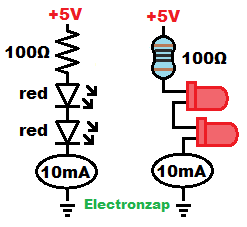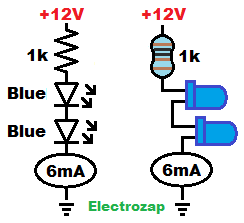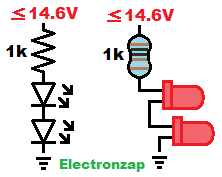Table of Contents
Semiconductors add up their voltage drops when they are connected in series. Therefore, 2 forward biased LEDs that are connected in series, and have the same forward voltage, will drop two times as much voltage as one of the LEDs will drop by itself.


If the forward voltages are uneven, says 2V for a red LED, and 3V for a blue LED, then their voltages need to be added up instead of multiplied. In the case of a red indicator LED and a blue indicator LED being connected in series, you can expect their forward voltages to add up to about 5V.

- Two red LEDs connected in series tend to drop a total of 4V (2V each).
- Two Blue LEDs connected in series tend to drop a total of 6V (3V each).
- Twice as much light at the same current (if they are the same color). Blue LEDs are brighter than red LEDs at the same current.
- There’s less voltage across the current limiting resistor thanks to the additional voltage drop. Resulting in less waste heat.
- Two series red (or any other color) LEDs can be powered with a 12V LiFePO4 being charged at 14.6V if a 1,000Ω ohm or higher value resistor limits the current.
- 14.6V – 4V (two series red LED forward voltages) = 10.6V across a 1,000Ω resistor.
- 10.6V/1,000Ω = 0.0106A (10.6mA) current through the circuit.
- 10.6V x 0.0106A = 0.11236W that the resistor creates. A little but below the 0.125W recommendation limit for a 0.25W maximum resistors.
Good pages to check out next:
To support this site, check out the following links:
- Check out my YouTube videos! https://www.youtube.com/c/Electronzap/videos
- Products I used in my videos or otherwise think look like a good buy. As an Amazon associate, I earn from qualifying purchases. My Amazon affiliate page showing products I think look good
- Information on this site is not guaranteed to be accurate. Always consult the manufacturer info/datasheet of parts you use. Research the proper safety precautions for everything you do.
- Electronzap is a participant in the Amazon Services LLC Associates Program, an affiliate advertising program designed to provide a means for sites to earn advertising fees by advertising and linking to amazon.com.